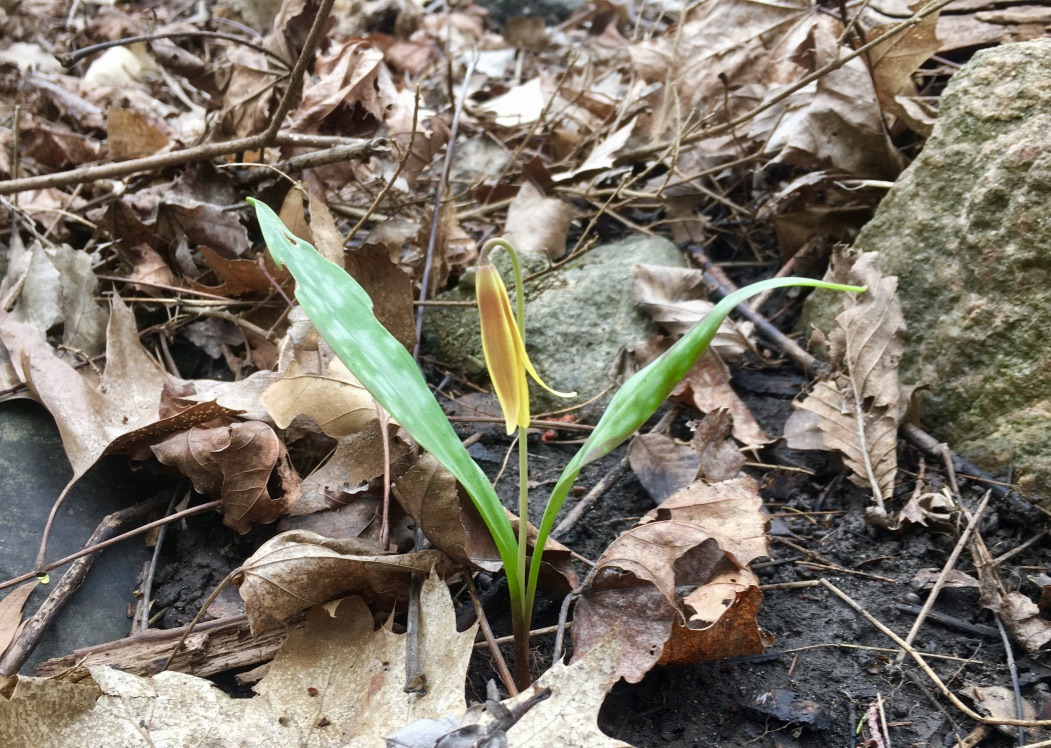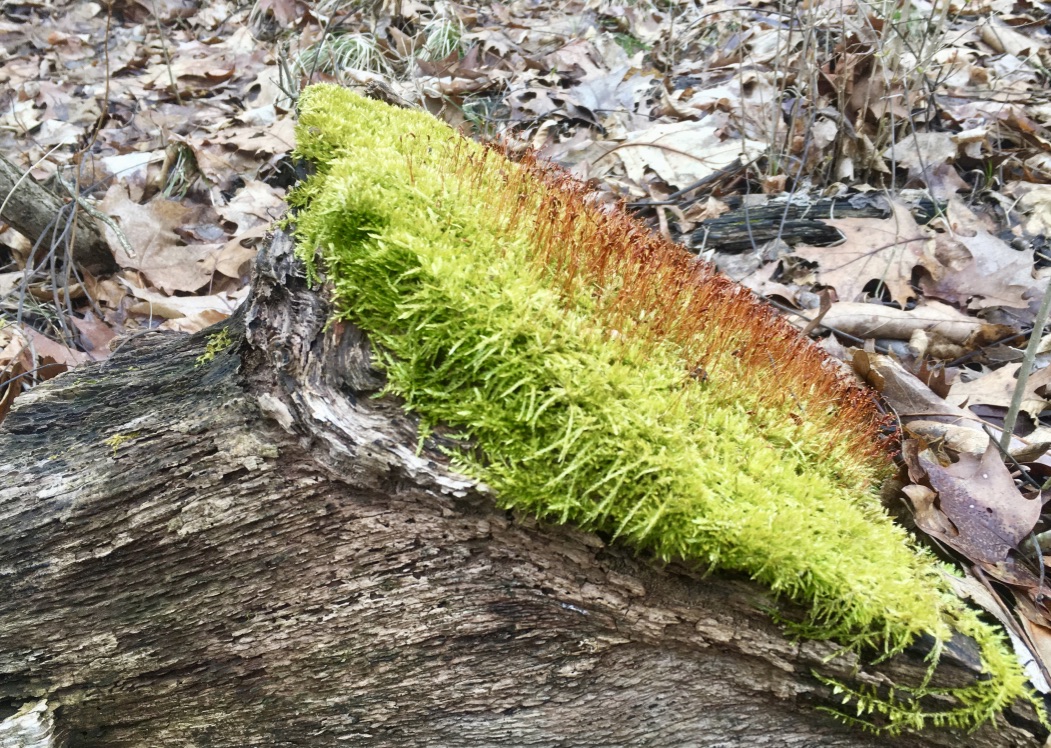
Our origins are of the earth. And so there is in us a deeply seated response to the natural universe, which is part of our humanity.
Rachel Carson1
There was a light rain, on the day that our school celebrated Earth Day. Even so, I decided to take my science classes out to the woods for a silent walk to observe the little ways that spring was taking hold in this cold and wet April. One by one, with ample space between each, the kids quietly walked a stretch of our creek-side path through a narrow streak of scrappy woods. My heart warmed with the sight of them slowly walking, looking around and up, sometimes touching things or stopping for a few seconds to watch the creek water flow by. These kids, most of them non-stop talkers, were magically silent.
When we got to the end of the path, we gathered on an old cement bridge spanning our creek to share our observations. The kids noticed many things: the smell of rain and wet earth, birds singing, the sound of water rushing, green plants coming up out of the leaf litter, a few small flowers beginning to bloom. We spent our remaining time having stick races from the bridge and crossing the creek on stepping-stones. It was really lovely. No one complained about the rain, but several kids thanked me, and I heard many cries of disappointment when the time was up. It’s a good thing that we will go out again soon!

Many kids at school tell me that they do not spend much, if any, time outside of school exploring in a natural setting. This may be related to recent studies that have found that children between the ages of 2 and 18 are engaging with screens between 4.5 and 9 hours per day depending on their age, and that number excludes time spent doing work associated with school. Similar studies have discovered that adults in the United States spend over 11 hours per day on average looking at and interacting with screens.2 It does not seem a stretch to suggest that, for many of us, precious leisure time outside of our scheduled activities appears to be spent in a virtual world.
This disconnect from the earth is to the detriment of the health of both the planet and ourselves. There is mounting evidence of climate change and other numerous environmental challenges, which indicates a lack of care and understanding of natural systems. In addition, one doesn’t have to look long to find a multitude of reports relating to human mental health and increases in loneliness, depression, isolation, and behaviors associated with rage.3 We are pacing the cage in discontent, but many do not seem to recognize the ways that the typical modern American lifestyle actually contributes to the confinement of our spirit.
The word “human” and the word “humus” (as in rich soil) are rooted in the same Proto-Indo-European word for “earth”.4 We are earthlings. People of the earth. We yearn for connection to real life and often we do not recognize that this is what we yearn for because we are so separated from the living breathing world. We are creatures who have become increasingly more disconnected from the reality of our creatureliness as our modern, technological world has grown.
Taking the time to regularly walk a forest trail or sit for a while surrounded by other wildly living things is an integrating and freeing experience that connects you to a reality that is so much larger than your own small life. Encountering the real, sensual world of nature may enliven you in ways you do not expect if you haven’t done so in a long time. Time in nature fills me with awe and wonder for the beauty and complexity to be found, and with gratitude for its existence. It is a homecoming; a healing and grounding practice; an opening for spiritual renewal. My awareness of the cycles and changes and habits of other living things places me upon the earth with them. They are not strangers, and I realize that they and I are threads in a common weaving.

In the past 10 weeks, over the course of several walks, I have traveled through the end of winter and into the slow unfolding of the first half of spring—a time when those of us in the top quarter latitudes of the earth are hungry for the color green. Now, as April turns to May, our winter hunger is feeling tended. The daffodils are peaking, and small leaflets are visible on the branches of trees. After several rains, the grass is vibrant. A few weeks ago the geese returned, honking and squawking as they flew back to their nesting areas. All of this is just the beginning of the flood of life that will come within the next several months.
I could tell you more about what I have noticed, like the ways that the shadows of the trees have changed or about the transformation of the watery places, but what I really want to do here is to encourage you to go and see for yourself. Ideally, go to the nearest place that will take you deep enough not to see many signs of the world built by people, but if a city park is a more realistic option, go there. If you already have a habit of doing this then you understand. Invite a friend who has not gone for a walk like this in a long time to accompany you. If you have a child, take them with you to explore.

When you get there, breathe deeply, open your eyes and listen. When you come to a patch of moss, bend down and stroke it lightly with your fingers. Notice the rich textures all around you. Look up and look down and see the endless variation in shades of green and brown and whatever other colors you can find. Lean in and smell the bark of the trees. Feel the way your feet navigate the uneven, unpaved earth. Let go. Allow yourself to be amazed and to be a part of it all. You don’t have to stay for a long time but try to return again soon. Look for changes. There is always something new. Your identity as an earthling among other earthlings will grow.
To really value and love something, you must first be aware of it and then spend time with it. When you expand your awareness of the rhythms and beauty of nature, you may also discover great interior riches that offer healing and sustenance. The love that blossoms within you as your connections deepen may radiate out to grace the very earth you are walking on and the lives of others upon it.

Ripe Fruit:

Poor Will’s Almanack: Bill Felker is a long-time daily observer of nature. Each week he records a sweet 3-5 minute podcast for WYSO Public Radio in Yellow Springs, OH (also syndicated on NPR) in which he shares his tender phenological observations of seasonal changes around his home and connects them with bits of old and new knowledge, and little stories from his own life. Something to look forward to every Tuesday! Check out this episode that connects to deeply experiencing the world outside your door:
Poor Will’s Almanack: April 23 – 29, 2019
https://www.wyso.org/post/poor-wills-almanack-april-23-29-2019
Illuminating Article:
“Real Wealth Resides Under Our Feet”, by David Korten, Yes Magazine, April 23, 2019

“Humans lived nearly 200,000 years without money. No human has ever lived without soil.
Somehow the extent of our human dependence on soil as the foundation of life and all real wealth had previously escaped me. Without soil, Earth is just another dead planet among the trillions of such planets in the cosmos. We would not exist. Could anything be of greater value to us than dark, rich soil teeming with microbiomes, worms and insects?”
Notes and Sources:
1: Epigraph: Carson, Rachel & Linda Lear, editor. (1998) “The Real World Around Us” in Lost Woods: The Discovered Writing of Rachel Carson, Beacon Press, Boston. p 160
2: Brooks, Mike. (12/26/2018) How Much Screen Time is too Much?, Psychology Today, https://www.psychologytoday.com/us/blog/tech-happy-life/201812/how-much-screen-time-is-too-much
3: Ali, Shainna, PhD. (7.12.18). What You Need to Know About the Loneliness Epidemic, Psychology Today, https://www.psychologytoday.com/us/blog/modern-mentality/201807/what-you-need-know-about-the-loneliness-epidemic
4: Vadella, Joseph. (9/8/17) Origins of “Human”, in Linguistics: Historic and Modern (Blog, references included.) https://sites.psu.edu/josephvadella/2017/09/08/origins-of-human/
All photographs are my own.

Hi Michelle. I don’t know if you are still checking this blog site. I follow you on Medium as well. It seems you haven’t written in awhile. I hope all is well with you.
LikeLike
Hi Denise, you probably guessed that I don’t monitor this blog site much anymore! Thank you so much for reaching out. All is well, I have been very busy and took a break from Medium, trying to discern whether to keep loading my work on there for such a small return–though I was really grateful to receive their Creator Fellowship last fall! The thing is, if you want to try to publish anywhere else, your work is not accepted if it has appeared online in any form. I have literally put some of my best work into the void of Medium where maybe 20 people read it at best and then it sinks to the bottom. Just sorting the worth of that. . . and it has felt good to step away from the Medium grind for a little while 🙂 I do miss interacting with other writers, such as yourself. I may consider working more with some of Scrittura’s prompts to keep my chops up this summer and also going back to supporting my fellow writers. Thanks again for touching base! I hope all is well with you, too! Michelle
LikeLike